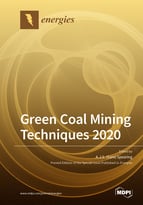Green Coal Mining Techniques 2020
A special issue of Energies (ISSN 1996-1073). This special issue belongs to the section "H: Geo-Energy".
Deadline for manuscript submissions: closed (31 July 2020) | Viewed by 24057
Special Issue Editor
Adjunct Professor, WA School of Mines, Curtin University, Perth, Australia
Interests: waste disposal and backfilling; pillar design and monitoring; support design and monitoring; risk management
Special Issues, Collections and Topics in MDPI journals
Special Issue Information
Dear Colleagues,
In this Special Issue of Energy, we are going to focus on recent and emerging developments in coal mining that have or could have a positive impact on society. The topics are not limited to the keywords below, the only criterion is that there must be a positive impact on society, which clearly includes the workforce. I hope that you will consider submitting a manuscript for peer review into this Special Issue.
Yours sincerely,
Prof. Dr. A.J.S. (Sam) Spearing
Guest Editor
Manuscript Submission Information
Manuscripts should be submitted online at www.mdpi.com by registering and logging in to this website. Once you are registered, click here to go to the submission form. Manuscripts can be submitted until the deadline. All submissions that pass pre-check are peer-reviewed. Accepted papers will be published continuously in the journal (as soon as accepted) and will be listed together on the special issue website. Research articles, review articles as well as short communications are invited. For planned papers, a title and short abstract (about 100 words) can be sent to the Editorial Office for announcement on this website.
Submitted manuscripts should not have been published previously, nor be under consideration for publication elsewhere (except conference proceedings papers). All manuscripts are thoroughly refereed through a single-blind peer-review process. A guide for authors and other relevant information for submission of manuscripts is available on the Instructions for Authors page. Energies is an international peer-reviewed open access semimonthly journal published by MDPI.
Please visit the Instructions for Authors page before submitting a manuscript. The Article Processing Charge (APC) for publication in this open access journal is 2600 CHF (Swiss Francs). Submitted papers should be well formatted and use good English. Authors may use MDPI's English editing service prior to publication or during author revisions.
Keywords
- environmental sustainable mining
- backfilling
- waste disposal
- subsidence
- safety
- improved ventilation
- emissions reduction






